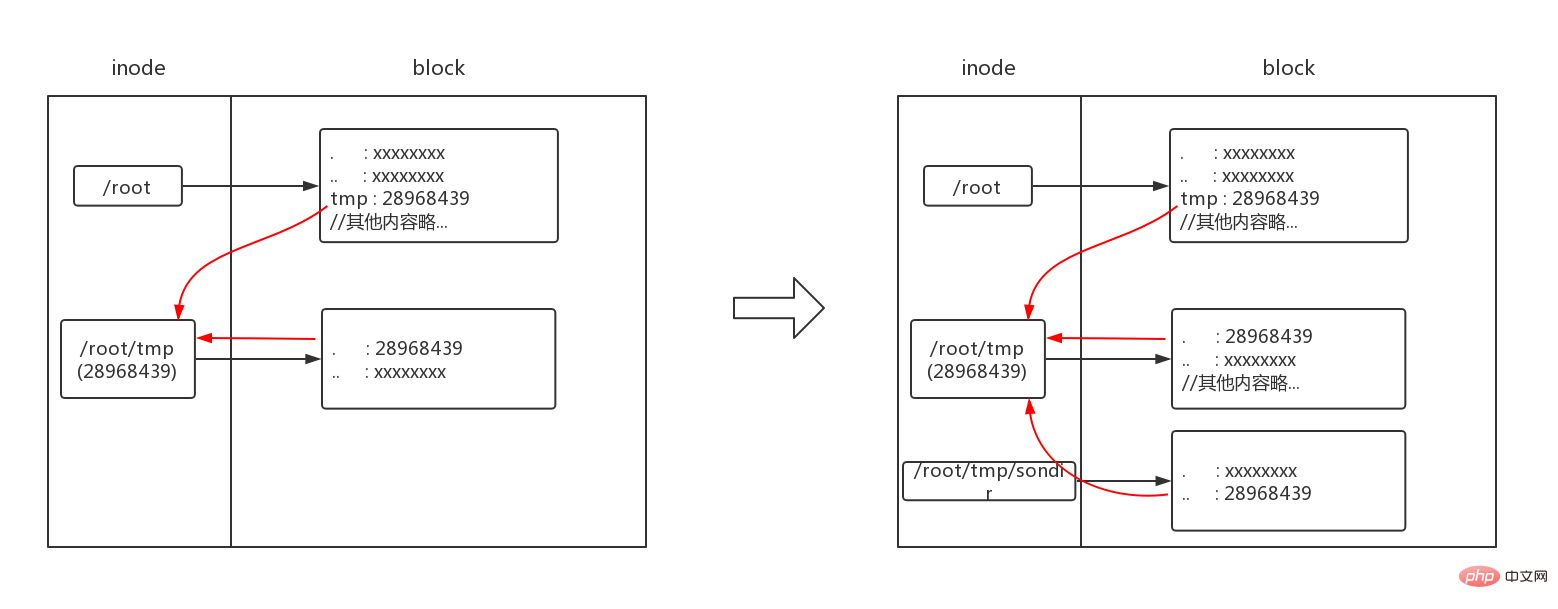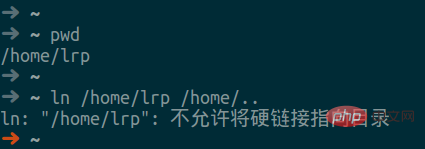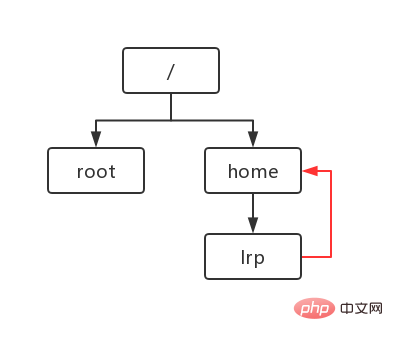 Operation and Maintenance
Operation and Maintenance
 Linux Operation and Maintenance
Linux Operation and Maintenance
 Why can't Linux hard links link directories?
Why can't Linux hard links link directories?
Why can't Linux hard links link directories?
Reason: Introducing a hard connection to the directory may introduce a loop in the directory. When the directory is traversed, the system will fall into an infinite loop, which will result in the inability to locate the access directory. The directory structure of Linux is a tree with "/directory" as the root node. If custom hard links are allowed, it is likely to destroy this structure and even form a loop; and once a loop is formed, for commands that need to traverse the directory tree , is fatal. Therefore, in order to avoid damaging the directory tree structure, Linux does not allow users to customize hard links on the directory.

#The operating environment of this tutorial: linux7.3 system, Dell G3 computer.
LINUX hard links cannot be linked to the directory because the introduction of a hard link to the directory may introduce a loop in the directory. When the directory is traversed, the system will fall into an infinite loop, which will result in the inability to locate the directory. Visit catalog.
In the Linux system, each file (directory is also a file) corresponds to an inode structure. The inode data structure contains information about the file type (directory, ordinary file, symbolic link file, etc.), and That is to say, the operating system can determine the symbolic link when traversing the directory. Since it can determine the symbolic link, of course it can take some measures to prevent entering an excessive loop. The system stops traversing after encountering 8 symbolic links in a row. This This is why directory symbolic connections do not enter an infinite loop. However, for hard connections, due to the limitations of the data structure and algorithm used in the operating system, it is currently impossible to prevent such an infinite loop.
The essence of hard connection in linux
Before discussing the problem, let’s talk about the essence of hard connection.
The hard link is actually the content of the block pointed to by the inode of the directory. Each record in the directory block is a hard link. The directory itself is a type of file in Linux (directory file, symbol d), and the file content of the "directory file" is a hard link.
For example (note the change in the number of directory connections in the picture):

The diagram before and after the change in the number of tmp directory connections is as follows (the red line indicates the source of the connection number) ):

Through the above example, we can find that the number of hard links when a directory is just created is 2, one of which comes from the parent directory and the other from itself. of".". If you create a subdirectory for the directory, the number of hard connections will change from 1 to 3. This is because there is an additional ".." connection from the subdirectory.
Some people may ask here, doesn’t it mean that hard links cannot be used for directories? What's going on with the demo above?
A concept needs to be clarified here, "hard links cannot be used for directories", which means that hard links to directories cannot be customized by users, but can only be maintained by the operating system. In fact, directories and hard links are inseparable and integrated with each other. The "hard link" itself is actually the way a directory maintains its sub-file names & sub-directory names.
The nightmare of custom hard connections: loops
After talking about the nature of hard connections, we can return to today’s topic: why not Allow user-defined hard links to directories?
We know that the directory structure of Linux is a tree with "/directory" as the root node. If custom hard links are allowed, it is likely to destroy this structure or even form a loop. For example, the following command If it can be executed successfully:


Once a loop is formed, it is fatal for commands that need to traverse the directory tree (for example, from top to bottom The du command that traverses from bottom to top, and the pwd command that traverses from bottom to top). Therefore, in order to avoid damaging the directory tree structure, Linux does not allow users to customize hard links on the directory. The reason why soft links do not have this restriction is that soft link files have a special file type that can be recognized by the system, while "hard link files" are no different from normal files of the system and cannot be judged.
Related recommendations: "Linux Video Tutorial"
The above is the detailed content of Why can't Linux hard links link directories?. For more information, please follow other related articles on the PHP Chinese website!

Hot AI Tools

Undresser.AI Undress
AI-powered app for creating realistic nude photos

AI Clothes Remover
Online AI tool for removing clothes from photos.

Undress AI Tool
Undress images for free

Clothoff.io
AI clothes remover

Video Face Swap
Swap faces in any video effortlessly with our completely free AI face swap tool!

Hot Article

Hot Tools

Notepad++7.3.1
Easy-to-use and free code editor

SublimeText3 Chinese version
Chinese version, very easy to use

Zend Studio 13.0.1
Powerful PHP integrated development environment

Dreamweaver CS6
Visual web development tools

SublimeText3 Mac version
God-level code editing software (SublimeText3)

Hot Topics
 What computer configuration is required for vscode
Apr 15, 2025 pm 09:48 PM
What computer configuration is required for vscode
Apr 15, 2025 pm 09:48 PM
VS Code system requirements: Operating system: Windows 10 and above, macOS 10.12 and above, Linux distribution processor: minimum 1.6 GHz, recommended 2.0 GHz and above memory: minimum 512 MB, recommended 4 GB and above storage space: minimum 250 MB, recommended 1 GB and above other requirements: stable network connection, Xorg/Wayland (Linux)
 Linux Architecture: Unveiling the 5 Basic Components
Apr 20, 2025 am 12:04 AM
Linux Architecture: Unveiling the 5 Basic Components
Apr 20, 2025 am 12:04 AM
The five basic components of the Linux system are: 1. Kernel, 2. System library, 3. System utilities, 4. Graphical user interface, 5. Applications. The kernel manages hardware resources, the system library provides precompiled functions, system utilities are used for system management, the GUI provides visual interaction, and applications use these components to implement functions.
 vscode terminal usage tutorial
Apr 15, 2025 pm 10:09 PM
vscode terminal usage tutorial
Apr 15, 2025 pm 10:09 PM
vscode built-in terminal is a development tool that allows running commands and scripts within the editor to simplify the development process. How to use vscode terminal: Open the terminal with the shortcut key (Ctrl/Cmd). Enter a command or run the script. Use hotkeys (such as Ctrl L to clear the terminal). Change the working directory (such as the cd command). Advanced features include debug mode, automatic code snippet completion, and interactive command history.
 How to check the warehouse address of git
Apr 17, 2025 pm 01:54 PM
How to check the warehouse address of git
Apr 17, 2025 pm 01:54 PM
To view the Git repository address, perform the following steps: 1. Open the command line and navigate to the repository directory; 2. Run the "git remote -v" command; 3. View the repository name in the output and its corresponding address.
 How to run java code in notepad
Apr 16, 2025 pm 07:39 PM
How to run java code in notepad
Apr 16, 2025 pm 07:39 PM
Although Notepad cannot run Java code directly, it can be achieved by using other tools: using the command line compiler (javac) to generate a bytecode file (filename.class). Use the Java interpreter (java) to interpret bytecode, execute the code, and output the result.
 Where to write code in vscode
Apr 15, 2025 pm 09:54 PM
Where to write code in vscode
Apr 15, 2025 pm 09:54 PM
Writing code in Visual Studio Code (VSCode) is simple and easy to use. Just install VSCode, create a project, select a language, create a file, write code, save and run it. The advantages of VSCode include cross-platform, free and open source, powerful features, rich extensions, and lightweight and fast.
 What is the main purpose of Linux?
Apr 16, 2025 am 12:19 AM
What is the main purpose of Linux?
Apr 16, 2025 am 12:19 AM
The main uses of Linux include: 1. Server operating system, 2. Embedded system, 3. Desktop operating system, 4. Development and testing environment. Linux excels in these areas, providing stability, security and efficient development tools.
 vscode terminal command cannot be used
Apr 15, 2025 pm 10:03 PM
vscode terminal command cannot be used
Apr 15, 2025 pm 10:03 PM
Causes and solutions for the VS Code terminal commands not available: The necessary tools are not installed (Windows: WSL; macOS: Xcode command line tools) Path configuration is wrong (add executable files to PATH environment variables) Permission issues (run VS Code as administrator) Firewall or proxy restrictions (check settings, unrestrictions) Terminal settings are incorrect (enable use of external terminals) VS Code installation is corrupt (reinstall or update) Terminal configuration is incompatible (try different terminal types or commands) Specific environment variables are missing (set necessary environment variables)





